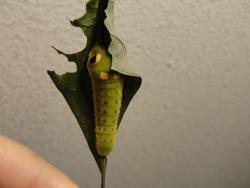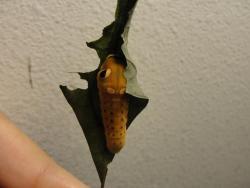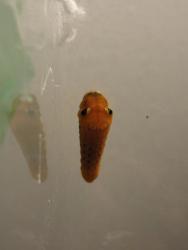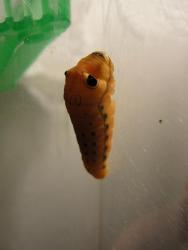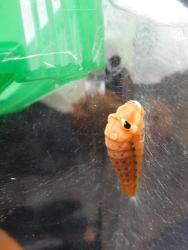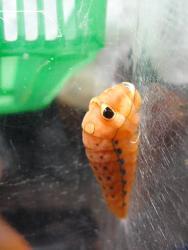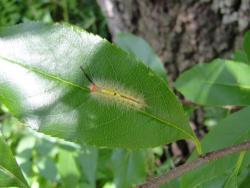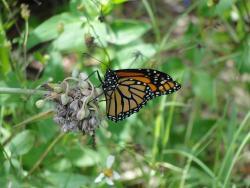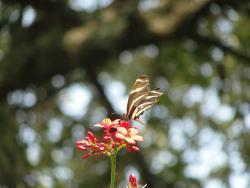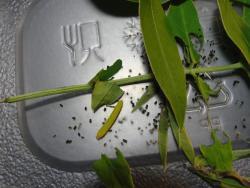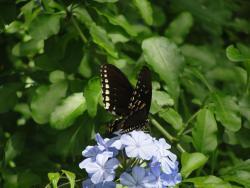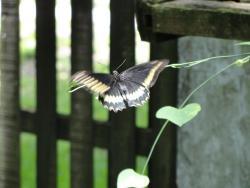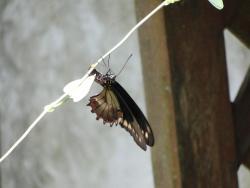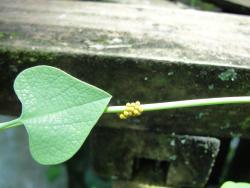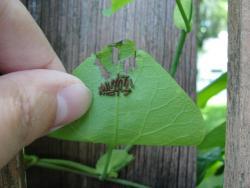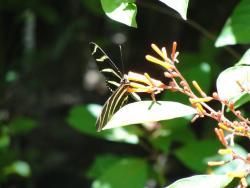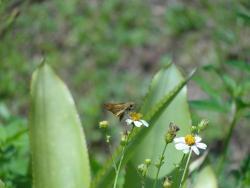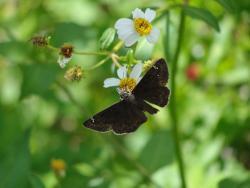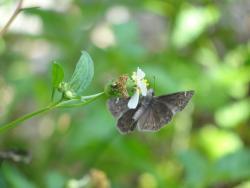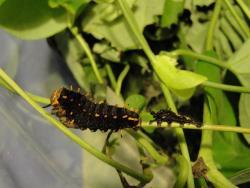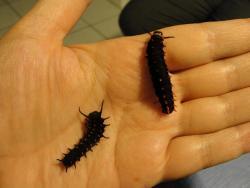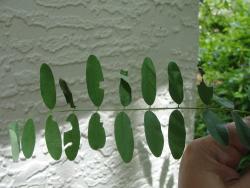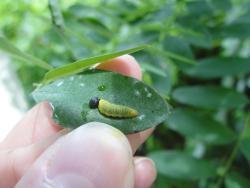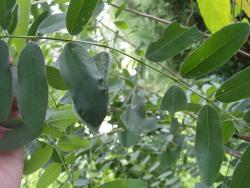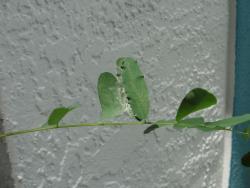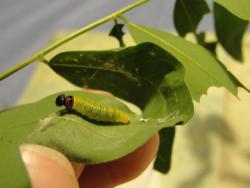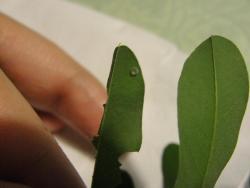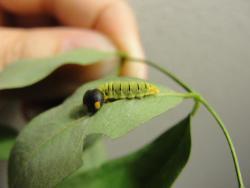Well, there's only one strange carpet man and I happened to see him pull in when I was picking caterpillar food this morning. Which means I had to do the obligatory "good morning" thing and let me tell you, this man is way too alert and jovial for this early in the morning. Maybe I should have had him get some Starbucks for me because he's clearly been doing espresso shots. Technically, he's not a stranger because he married Mom's church friend last year and I think he goes to church with her, too. But I don't know him so he's strange to me. I actually hear a woman's voice that's not Mom so I think maybe her friend came, too. So I'm definitely going to hide in here (I have my reasons). At least being alert is probably a good trait to have if you're laying carpet. He's only doing three rooms (one of which is not mine but borders mine) so I feel pretty safe in here. To be fair, the house turns 20 in August so that's how old the carpet is. It really does need to be replaced. I just wonder how long this whole process takes. I might rethink the movie thing and go back to bed if he leaves early enough. I woke up at 3:30 (weird dreams) and I've been mostly awake ever since. But I'm ready to go back to sleep and now I can't. Bummer because that Zyrtec I took is really kicking in.
Anyway, I promised a post about molting so here it is. Like I said, I'm running on little sleep and no caffeine yet so if I don't make sense just ask me questions and I'll try to do better the second time around. Now, there comes a special time in every caterpillar's life when he needs to molt (or shed his skin when one kid at MOSI asked me what "molt" meant). This is how they grow bigger; their skin doesn't expand like humans. Caterpillars do this five times during their life (for the most part; I'm sure there are exceptions). Each time they molt we call it an instar. Technically, the first instar is when they're hatched from the egg but after that each molt is an instar except the fifth and final molt which is when they pupate and make a chrysalis.
This is a very critical time in a caterpillar's life where they are very vulnerable! I tell you guys this because I killed my fair share of caterpillars before I figured out what they were doing. When they molt, they find a safe space, lay down a silk pad, attach themselves to it, and stay there for the several hours it takes to molt. I kept panicking, thinking they weren't eating and maybe they couldn't find the food, so I kept moving them and killing them. By the way, with the exception of Monarchs and Polydamas STs, caterpillars don't eat all the time. Ok, I'm even joking a little about the Monarchs and Polydamas. Sometimes I think they just need to rest and digest so don't go bothering them unless you have to (like to clean the cage or show them off to guests).
But even when you have to move them, make sure they are not molting! Here's why. Once the caterpillar attaches itself to that silk pad, it can't move. You see, molting is a lot like trying to take your socks off without using your hands. Imagine that for a second. Just shaking your foot around won't do it because socks fit pretty tight (if not, buy new ones). You have to have something to hold them in place, like your fingers, so you can slide your foot out of the sock. Well, caterpillars don't have fingers. What they do have is silk. They attach themselves to that silk pad, and when they begin to wriggle out of their skin, it's that silk pad that holds the old skin down and allows them to slip out of it. FYI, caterpillars will build their silk pads on a leaf, stem, or most often in my case, the sides of my plastic cage. At the museum, they often do it on the side of the glass aquariums we use. I think they prefer to be vertical when they do it. Maybe gravity helps?
So that begs the question, "Melanie, how do I know if my caterpillar is molting?" This is important and also helps explain why you can't move them once they've started the process. You see, when they molt, their head capsules get really low on their head. The old one actually detaches from the caterpillar but to the human eye it looks like it's just hanging low. I was once collecting cats at MOSI and showed one of the guys on the cleaning crew and he asked me why it looked like it had two heads. He had good eyes for a non-trained person! Here's a picture of a Polydamas I have that's in the process right now.

See that yellowish line right in the middle? That's where his osmeterium come out. Normally, the head capsule is flush against it. But when they molt, the head capsule slips low because it's making way for the new head capsule underneath it. All caterpillars do this (as far as I've seen) even those without osmeterium (I'm just using that as a guide for this species) so learn how your caterpillar normally looks and where his head capsule normally is so you can tell when it lowers. I mean, you should be able to see the new head capsule forming below it as it will pretty much always be paler in color (like in the photo).
Now, the head capsule lowering covers up a very important part of the caterpillar - their spinneret! Some butterfly site I just looked at says the spinneret is on their lower lip but I always think of it like if caterpillars had chins that's where it would be. Either way you want to look at it. I totally just stole this image from Monarch Watch. But I just bought some t-shirts from them so I think we're cool. Plus, I gave them credit!
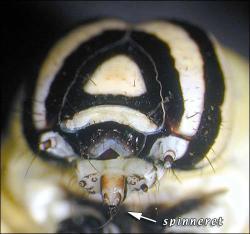
Remember that silk pad? Once the caterpillar starts the molting process the head capsule lowers and covers up the spinneret! So if you move them they cannot spin another silk pad to attach to! This is why you don't move a molting caterpillar! They won't have that anchor to pull off their skin and they will die trying to molt! The only exception I've ever seen to this rule is the Monarch. I don't know if they're anatomically special or what, but I have seen them be able to spin another silk pad even with a lowered head capsule. But let's not chance it, folks. Just don't move them.
So what if you accidentally knock one down or the other caterpillars knock one down or you just find one laying in the bottom of your tank like my Pipevine ST the other day? The best thing you can do is find some silk. Look around the tank or whatever you've got them in. Some caterpillars are notorious for silking pretty much the entire enclosure so you may get lucky. In my case from the other day, I found where a previous caterpillar had probably spun his silk pad and I took the caterpillar and pressed him against it. It took a few tries, but he stuck and a few hours later he molted. If I had thought harder and not panicked, I would have taken a leaf out of the Spicebush ST's tank because they build silken homes with LOTS of silk. Probably would have worked better. Other things you can try if you're desperate is sticking them to the sticky side of scotch tape (or other tape, I suppose). Or, if you've got the time, just sit there and watch the caterpillar. When he starts moving (kind of undulating) like he's wanting to molt, take your finger and GENTLY press down on his back end. If you can hold down his old skin he can still wriggle free. If you get desperate, take a pin and pin his rear end to something that will hold. Be extremely careful doing this as you only want to pin the old skin and not the new caterpillar forming underneath. That is expert level caterpillar care so only do that if you feel comfortable or are terribly desperate. I've only done that a couple of times, myself.
A caterpillar molts first, and then it will shake off its old head capsule. Often, parts of the caterpillar will appear paler in color, especially the head capsule and their legs (both true legs and prolegs). Here's a couple of images I have of a Gulf Fritillary. As you can see, they are normally an orange cat with black spikes. But after they molt, they are totally orange for a short time until the spikes turn black again. I honestly have no idea why that happens. Like, when that Polydamas in the above picture molts, his head capsule will be that pale color for a little while (like half an hour, maybe) until it goes back to the usual dark brown color you see on the old head capsule.
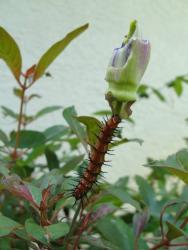
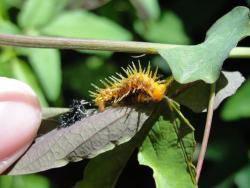
You can see the old skin behind the Gulf Frit cat is mostly his black spikes. I've had people see this before and think that one caterpillar ate another caterpillar and those are the remains. Nope, that's just where it molted.
Don't ever be afraid to ask what you might think is a stupid question because we've probably had them, too. When I first raised caterpillars, I thought the silk came out of their rear end because that's how spiders seem to do it. I don't know when I learned it was coming from under their mouth but I felt kind of dumb for not knowing that. But unless you read it or someone tells you, it's not like you learn this kind of detail in school. Besides asking us experts, the best way to learn is to simply watch your caterpillars in action. And as much as I like "Game of Thrones", caterpillars are way more interesting than TV. Each species acts a little different than the others which is why I have a goal of trying to raise every species I can get my hands on!
Ok, I just re-read that and I think it mostly makes sense but ask away if you have questions. I'm thinking of sneaking out to the kitchen and maybe making some tea.




